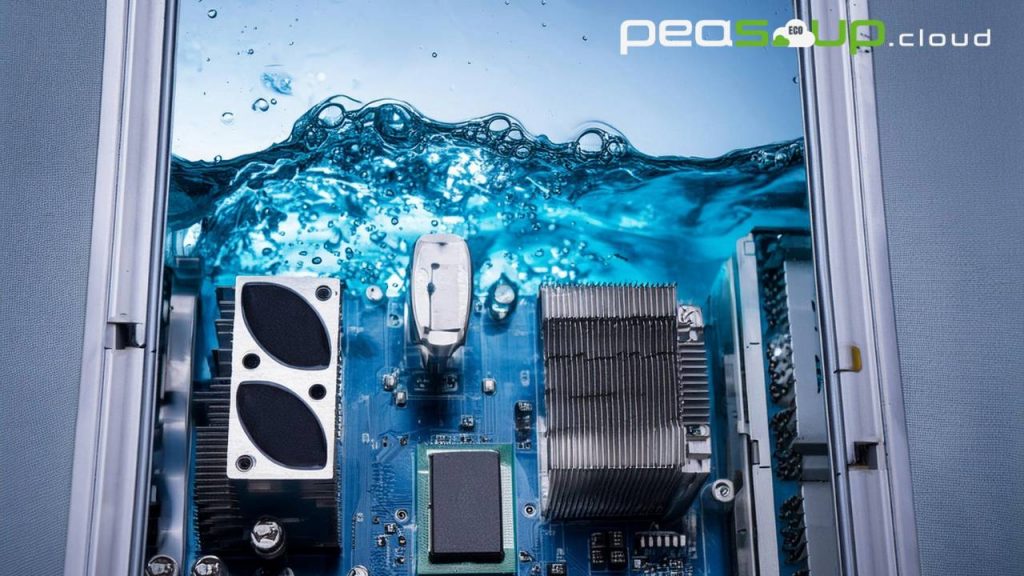Direct to Chip vs Immersion Cooling
As data centres keep packing more processing power into smaller spaces, traditional air cooling struggles to keep up.
This escalating heat problem necessitates innovative solutions. Two technologies are taking centre stage nowadays; direct-to-chip (DTC) and immersion cooling.
But how do they compare, and which one reigns supreme?
This guide dives deep into their functionalities, advantages, and potential to keep your data centre cool and efficient.
Direct to Chip Cooling
Targeted Efficiency for High-Performance Computing
DTC cooling utilises cold plates that make direct contact with CPUs and GPUs. A coolant, typically water (or a water-glycol mixture), circulates through these plates, absorbing heat and transferring it away. This targeted approach is ideal for high-performance computing (HPC) environments where maximising performance and minimising heat are crucial.
Benefits
- Higher Performance – Water’s superior thermal conductivity allows for excellent heat removal, perfect for demanding workloads.
- Reduced Energy Consumption – Efficient heat transfer translates to less power needed for cooling fans, leading to lower energy bills.
- Cost-Effective (Long Term) – While the initial setup might be pricier than air cooling, lower energy costs offer significant long-term savings.
Drawbacks
- Leakage Risk – Leaks can be catastrophic for delicate electronics, requiring robust leak detection systems.
- Limited Cooling – Only core components are directly cooled, potentially neglecting other heat-generating parts like memory modules.
- Maintenance Challenges – Servicing a network of water channels within servers can be complex.
Immersion Cooling
A Bath of Efficiency for Scalability
Immersion cooling takes a more holistic approach. Servers are submerged in a non-conductive dielectric fluid that absorbs heat across the entire system!
This comprehensive approach eliminates hot spots and provides a safer environment for sensitive electronics.
Benefits
- Uniform Cooling – All components are bathed in the coolant, eliminating hot spots and ensuring consistent cooling throughout the server.
- High Performance – The coolant’s superior thermal conductivity allows for excellent heat removal, perfect for high-demanding applications such as AI and ML.
- Reduced Risk of Leaks – Leaks pose a smaller threat as the fluid isn’t in direct contact with electrical components, offering increased peace of mind.
- Low Noise Levels – Since fans are no longer needed for cooling, immersion cooling leads to quiet data centre operations.
Drawbacks
- Higher Upfront Costs – Implementing large-scale immersion tanks and coolant the required infrastructure can be expensive.
- Maintenance Considerations – Handling the fluid during maintenance adds more complexity compared to traditional air-cooled systems.
- Limited Scalability – Scaling existing air-cooled data centres to immersion might require significant infrastructure changes.
- Maintenance – Servicing requires training and understanding of the technology making it more complex.
PeaSoup Cloud
Embracing the Future of Data Center Cooling
At PeaSoup, we were the first cloud provider in the UK to use liquid immersion cooling commercially. We understand the importance of efficient and sustainable data centre operations. That’s why we leverage the power of liquid immersion cooling to keep your data cool, secure, and performing at its peak.
The Future
Both DTC and immersion cooling offer great advantages over traditional air cooling and offer great performance and efficiency, however, immersion cooling provides a more comprehensive and potentially safer approach.
The near future might see a hybrid solution, with DTC for core components and immersion for overall system cooling. Additionally, advancements in fluid properties, leak detection systems, and infrastructure design could further enhance both technologies.
Looking for a future-proof data centre solution?
PeaSoup’s cutting-edge immersion cooling technology ensures optimal performance, minimises energy consumption, and provides a reliable and secure environment for your data.
Contact us today to learn more about how your organisation can benefit from sustainable and high-performing cloud services.

